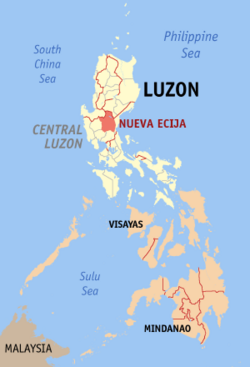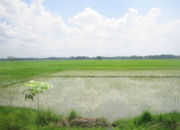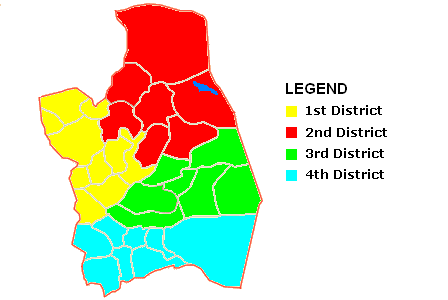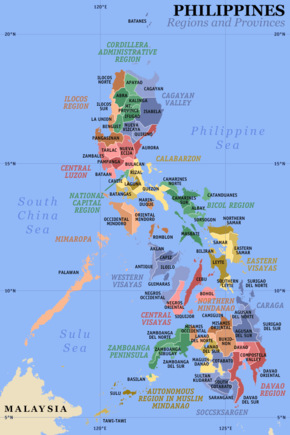Nueva Ecija
| Nueva Ecija | |||
|---|---|---|---|
| — Province — | |||
|
|||
 |
|||
| Coordinates: | |||
| Country | |||
| Region | Central Luzon (Region III) | ||
| Founded | 1705 | ||
| Capital | Palayan City† | ||
| Government | |||
| - Governor | Aurelio Matias Umali (Unang Sigaw Partido ng Pagbabago/Lakas-Kampi-CMD) | ||
| Area | |||
| - Total | 5,751.3 km2 (2,220.6 sq mi) | ||
| Area rank | 15th out of 80 | ||
| Population (2007) | |||
| - Total | 1,853,853 | ||
| - Rank | 10th out of 80 | ||
| - Density | 322.3/km2 (834.8/sq mi) | ||
| - Density rank | 18th out of 80 | ||
| Divisions | |||
| - Independent cities | 0 | ||
| - Component cities | 5 | ||
| - Municipalities | 27 | ||
| - Barangays | 849 | ||
| - Districts | 1st to 4th districts of Nueva Ecija | ||
| Time zone | PHT (UTC+8) | ||
| ZIP Code | |||
| Spoken languages | Tagalog, English, Kapampangan, Ilocano, Pangasinan | ||
| †Palayan City is the officially-designated capital and seat of government by R.A. 4475, though the provincial government still maintains its facilities in Cabanatuan City. | |||
Nueva Ecija (Filipino:Bagong Ekiha) (PSGC: 034900000; ISO: PH-NUE) is a landlocked province of the Philippines located in the Central Luzon region. Its capital is Palayan City. Nueva Ecija borders, from the south clockwise, Bulacan, Pampanga, Tarlac, Pangasinan, Nueva Vizcaya, and Aurora.
Contents |
History
Nueva Ecija was created as a military comandancia in 1777 by Governor General Clavería, with the capital, Josean at Baler (now part of Aurora). It was formerly part of the province of Pampanga. From its humble beginning, its land area grew to cover almost the entire island of Luzon. Spanish Records in the Philippines recognizes 2 Spanish countries in the Pacific-- Las Islas Filipinas and Nueva Écija. Poverty was the only reason why Nueva Ecija was not given recognition as a separate country from the Philippines by the King of Spain in 1840s. From 1777 to 1917, Nueva Ecija's territory was however subdivided to give way to the creation of other provinces. The Province of Tayabas (now Aurora and Quezon) including Polillo Islands, the provinces of Palanan (now Isabela), Cagayan, the province of Nueva Vizcaya, the territory which became part of the Province of Quirino, and the province of Manila north of the province of Tondo in 1867, and the District of Morong (now Rizal) were among those created out of Nueva Ecija.
During World War II the Imperial Japanese Army entered the province and Nueva Ecija was taken in 1942. In March 29, 1942, under the leadership of Luis Taruc the Hukbalahap (Hukbo ng Bayan Laban sa Hapon-People's Army Against the Japanese) was organized in Sitio Bawit, Barrio San Julian in the town of Cabiao. It was perceived to be the military arm of the Partido Komunista ng PilipinasCommunist Party of the Philippines, that brought about the beginning of the early organized resistance of the Pilipino people. In 1945, combined American and Filipino soldiers liberated Nueva Ecija with the recognized guerillas continuing to harass the Japanese at every opportunity. When Filipino soldiers of the 21st, 22nd, 23rd and 26th Infantry Division of the Philippine Commonwealth Army and the 2nd Infantry Regiment of the Philippine Constabulary was re-invading launches to entering liberated the province of Nueva Ecija and helping recognized guerrilla resistance fighter units, the Hukbalahap Communist guerrillas and the American troops against the Japanese Imperial forces during the Invasion of Nueva Ecija. On January 30, 1945 American Army Rangers, Alamo scouts and Filipino guerillas conducted a raid to liberate Allied civilians and prisoners of war in Cabanatuan, this was successful with over 516 rescued. By January 31, 1945, the liberated civilians and POWs reached Talavera, the rescue is commemorated in Talavera.
The province was named after the old city of Écija in Seville, Spain.
In 1896, Nueva Ecija became one of the first provinces to revolt against Spanish rule, and one of the provinces which declared its independence in 1898.
People and culture
Nueva Ecija ("New Écija") was settled in the last century by thousands of migrants from adjoining provinces such as Pampanga, Tarlac, Bulacan, Pangasinan, and Ilocos. Today Novoecijanos are descendants of these settlers and many still hold on to folk traditions that trace their ancestry to other provinces. About 77% of the people speak Tagalog as their first language. Much of the remainder are Kapampangan, Pangasinan, and Ilocano-speakers and they are concentrated in the cities and towns of the south and north,. There are small communities of Ilongots along the Caraballo and Sierra Madre Range as well as Agtas or Negritos.
Agriculture is the main industry of the people because of its naturally rich soil. Lowland crops such as rice, corn, onions, vegetables and sugarcane are produced in great quantities and Nueva Ecija is widely referred to as the "Rice Granary" of the country. Agriculture has played a vital role in molding the culture of the people. The typical Novo Ecijano family is tightly knit and is the basic working unit on the farm.
The May and June Festivals in Nueva Ecija are important Christian observances that are also occasions to ask for favors in ensuring a good harvest. In May, the Novo Ecijanos celebrate the feast of the patron of farmers, San Isidro. Food is served to overflowing in the belief that generosity results in bounty.
In Barangay Bibiclat, in the town of Aliaga there is a unique practice among the devotees of Saint John the Baptist. They cover their bodies with mud and dry leaves and vines to denote the humble origins of the Saint. Known as the taong-putik or the mud people, they ask alms and candles from the people and offering them to the Church during the special mass celebrated at 7:00 in the morning. They believe that such a practice will cure sickness and bring a bounty in the harvest.

Economy
Nueva Ecija is considered the main rice growing province of the Philippines and the leading producer of onions in the Municipality of Bongabon in South East Asia.
Major Industries
Nueva Ecija is one of the top producers of agricultural products in the country. Its principal crops is mainly rice but corn and onion are also produced in quantity. The province is often referred to as the “Rice Granary of the Philippines.” Other major crops are onion, mango, calamansi (calamondin orange), banana, garlic, and vegetables. The town of Bongabon at the eastern part of the province at the foot of the Sierra Madre mountains and its neighbouring Laur and Rizal are the major producers of onion and garlic. Bongabon is called the "onion capital of the country".
Education is very well established as a major industry in the province. The leading educational institutions are the Central Luzon State University in Munoz and Nueva Ecija University of Science and Technology, Wesleyan University-Philippines, La Fortuna College and Araullio University in Cabanatuan. There are 18 tertiary level intitutions in Cabanatuan City alone.
Health services is also a notable industry and a number of hospitals cater to patients from within Nueva Ecija and some coming from neighbouring provinces. There are also a number of schools of nursing and midwifery, mostly in Cabanatuan.
There are poultry farms in a number of towns, most notably, the Lorenzo poultry farms in San Isidro which is one of the largest in the country. Duck raising and egg production is also an important livelihood. Fishponds are unevenly distributed throughout the province but the largest concentrations are in San Antonio, Santa Rosa, and Cuyapo.
Fabrication of tricycle "sidecars" is widespread in the province, notably in Santa Rosa, where prices are as low as PhP 7,000 which is practically the cheapest in the country.
Several areas have mineral deposits. Copper and manganese have been found in General Tinio, Carranglan, and Pantabangan. The upper reaches of Carranglan and Palayan City are said to contain gold.
In June 2008, it has also received the title: "Milk Capital of the Philippines" due to the reason that Nueva Ecija gathers more milk from both cows and carabaos or water buffaloes than any other place in the Philippines.[1]. The Philippine Carabao Center is located in CLSU compound in Munoz City.
Government
Current Government Officials
Governor: Aurelio M.Umali
Vice Governor: Gay Padiernos
Congressional Representatives
|1st District: Josefina Joson |2nd District: Joseph Violago |3rd District: Czarina D. Umali |4th District: Rodolfo W. Antonino
2010 Local Elections
| POSITION | CANDIDATE | PARTY | TOTAL VOTES |
|---|---|---|---|
| Representative 1st District |
Josefina M. Joson | Balane-NPC |
|
| Representative 2nd District |
Joseph Gilbert F. Violago | Unang Sigaw- Lakas-Kampi-CMD |
|
| Representative 3rd District |
Czarina D. Umali | Unang Sigaw- Lakas-Kampi-CMD |
|
| Representative 4th District |
Rodolfo W. Antonino | Balane- Lakas-Kampi-CMD |
|
| Governor | Aurelio M. Umali | Unang Sigaw- Lakas-Kampi-CMD |
|
| Vice-Governor | Gay G. Padiernos | Unang Sigaw- Lakas-Kampi-CMD |
|
| Prov'l Board Members | |||
| 1st District | |||
| Estrellita B. Suansing | Unang Sigaw |
|
|
| Eduardo Rey G. Joson | Balane |
|
|
| Belinda E. Palilio | Unang Sigaw |
|
|
| 2nd District | |||
| Joseph R. Ortiz | Unang Sigaw |
|
|
| Edgardo F. Agliam | Unang Sigaw |
|
|
| 3rd District | |||
| Emmanuel Antonio M. Umali | Unang Sigaw |
|
|
| Johnero E. Mercado | Unang Sigaw |
|
|
| 4th District | |||
| Napoleon G. Interior | Unang Sigaw |
|
|
| Romanito D. Juatco | Balane |
|
|
| Teresita A. Patiag | Unang Sigaw |
|
|
| Boldface denotes Senior Board Member. | |||
Geography
Physical
The province is the largest in Central Luzon. Its terrain begins with the southwestern marshes near the Pampanga border. It levels off and then gradually increases in elevation to rolling hills as it approaches the mountains of Sierra Madre in the east, and the Caraballo and Cordillera ranges in the north.
Political
The governor as of 2007 is Aurelio Oyie Matias Umali , who assumed his governatorial duties after winning the 2007 election.
The province is divided into four congressional districts which consists of 27 municipalities and 5 cities.

Cities
- Cabanatuan City
- Gapan City
- Palayan City
- San Jose City
- Science City of Muñoz(website)
Municipalities
|
|
Tourist attractions
Nueva Ecija is the largest province and the biggest rice producer of Central Luzon and the Philippines, thus, often referred to as the “Rice Bowl of the Philippines.”
Historical
Gapan
The first Augustinian mission in lowland Nueva Ecija was founded in Gapan in 1595. It is home to a Roman Catholic church of Byzantine architecture built from 1856 to 1872.
Historic Barrio Labi (Bongabon)
The resthouse of the Quezon family is located in this barrio, along the National Highway going to Baler Aurora. It is also the place of death of Mrs. Aurora Quezon, wife of former Philippine President Manuel Luis Quezon.
Tabacalera of San Isidro
Centuries-old brick walls of the Tabacalera in San Isidro remain as witness to the Novo Ecijanos’ 100-year oppression, from 1782 to 1882, when the province became the center of the tobacco monopoly in Central Luzon and was thus restricted from raising other crops.
Gen Luna Statue and Marker (Cabanatuan City)
A statue of Philippine hero General Antonio Luna astride a horse stands at the plaza in front of the cathedral on the exact spot where the brave general was assassinated in 1899 in the city that adopted him subsequently.
Apolinario Mabini Marker (Cuyapo)
Site of the arrest of Philippine hero Apolinario Mabini, known as “the sublime paralytic,” by the Americans on December 10, 1899.
Trial House
Owned by revolutionary leader and Novo Ecijano General Manuel Tinio. Built during the early Commonwealth period, it features ornately designed turn-of-the-century furniture and a life-size figure of esteemed Nove Ecijano Don Kapitan Berong in stained glass.
Sedeco of San Isidro
The Grand Sedeco house in San Isidro, which General Emilio Aguinaldo frequented, marks this gallant town that has proven time and again to be cradle of Filipino heroes. It was here that General Frederick Funston planned the capture of Aguinaldo, first President of the Philippine republic, during the Philippine-American war.
Wright Institute of San Isidro
One of the first high schools established outside Metro Manila during the American period.
Dalton Pass
Located in Capintalan, Carranglan, the five-hectare area blessed with a cool climate houses the monument of General Dalton and a tower that borders the provinces of Nueva Ecija and Nueva Vizcaya. Uphill is a World War II memorial in black marble where a historical account of the war had been etched in English and Japanese.
Camp Pangatian (Cabanatuan City)
Began as a military training camp for twenty years until converted into a concentration camp for allied prisoners of war during the Japanese occupation. A popular tourist destination among war veterans by way of the WWII Veteran’s Homecoming Program.
Cultural
Churches of Nampicuan, Carranglan, and Pantabangan
Church ruins of identical Augustinian architecture can still be found in the three upland missions.
Natural
Minalungao Park
Declared as a national park, it features a breathtaking view of the narrow but deep Penaranda River. On both sides of the river bank are 16 meter high limestone walls. The ridge formation of white sculptured limestone walls shows the might of the great river.
General Luna Falls (Rizal)
The easternmost barrio of Rizal nestled uphill on the foot of the Sierra Madre mountain range boasts of one of Central Luzon’s hidden treasures: a towering waterfall of more than a hundred feet descending widely across a rocky mountain wall into over twenty pools of varying levels and depths.
Mt. Olivete (Bongabon)
A hundred-step stair leads to the church built by the Adarnista spiritual community on the mountaintop. Frequented by pilgrims who bathe in and drink the water of its springs believing it to be medicinal.
Gapintalan (Carranglan)
Maintained by the Kalanguya tribal community from Ifugao, its rivers and low-lying hill are ideal for hiking and communing with nature. A gateway to the Cagayan Valley, it was a strategic location during WWII’s liberation period. Tunnels, war artifacts, and stories of gold digging abound in the area.
Palaspas Falls
Located in San Jose City, it is ideal for picnics and bathing especially during summer.
Gabaldon Falls
The lure of Gabaldon, Nueva Ecija. The ten-feet falls are surrounded by huge rock formations and rippling ice-cold water. Located within the 200-hectare Sabani Estate Agricultural College.
Religious
Church of Penaranda (Nueva Ecija) – The church of Penaranda was erected in 1869 by Fr. Florentino Samonte. Construction was continued by Fr. Candicho San Miguel from 1879-1881 and by Fr. Santos Vega from 1887-1889. From 1889 to 1891, the parochial house of bricks and wood was built by Fr. Valentin Gatode la Fuente. Fr. Alvaro Callega built the original church with thatch-roof and stone walls
Man-Made
Diamond Park (San Jose)
Strategically located at the gateway to the Cagayan Valley, it is a haven for picnics and sightseeing. Its hundred-step stair leads to lamp-lit pagodas nestled on hilltops and offering a panoramic view of northern Nueva Ecija.
Pantabangan Dam
Built in 1974 along the Pampanga River to serve as reinforcement against flood, and provide irrigation, additional electricity in the entire Luzon island, the dam was built by Filipino engineers under the supervision of the National Irrigation Administration. Pantabangan Dam is now one of the most visited tourist spots in the province. The place offers a scenic view of the surrounding area. Tourists will also appreciate the dam's engineering wonders.
Philrice
The Philippine Rice Research Institute, located at Maligaya, Muñoz, Nueva Ecija, is the central station of agricultural experimentation, it is the only one of its kind throughout the country. It was created to develop and implement a natural rice research and development program, sustain the grains made in rice production and solve location-specific problems of the rice industry. A variety of rice wine is produced at the center.
Central Luzon State University (CLSU)
Located in the outskirts of the Science City of Muñoz, Nueva Ecija, the 658-hectare main campus of CLSU is famous for its old shady trees, model farm, vegetable and ornamental plant gardens. Nueva Ecija has been referred to as the “Agricultural Central of Luzon.”
Agricultural Museum (CLSU)
A socio-cultural arm for information in Central Luzon, it is the first and the only one of its kind in the country. The materials on display are preserved and maintained to promote the cultural heritage of Filipinos in Central Luzon. The museum has six sections: rice and vegetable planting implements; household ingredients utensils; personal apparel; hunting and fishing implements.
Living Fish Museum (CLSU)
Showcases indigenous and tropical freshwater fishes collected form different provinces in Luzon.
Rubber Dam
Llanera, Nueva Ecija - Asia's first and only rubber dam
Festivals
Taong Putik Festival of Aliaga
At the crack of dawn, scores of mud-covered, barely dressed devotees make their appearance, asking for alms and candles form the wide awake town folks. This practice mimics a biblical myth about St. John the Baptist, who was said to have done the same thing in his lifetime. A special mass culminates the occasion, reinforcing its spiritual nature to the people of Aliaga.
Holy Week Rituals of Puncan
The unique Holy Week rites of Puncan, one of the oldest towns in Nueva Ecija, are woven in folklore. Aside from the differing dialect, Pangasinense, widely used in Puncan, its distinct Lenten rituals include a hide-and-seek routine between the “Flagellante” and “Hudyo,” a children’s parade, and a choreographed version of Christian penitential rites in which participants with charcoal-smeared faces beat bamboos.
Special Interest
Farm Tours
Tour of agri-based institutions of Muñoz in Nueva Ecija, including a farming technology tour at the Central Luzon State University and plant tour of the Philippine Rice Research Institute (Philrice) and Philippine Carabao Center.
Gross Ostrich Farm
San Leonardo, Nueva Ecija - Located in Brgy. Tagumpay, San Leonardo, Gross Ostrich Farm grows, breeds and propagates imported ostriches both for human consumption and for tourism such as sale of decorative eggs, leather wallets, colorful feathers and other by-products. Ostriches reach a height of about 7 – 8 feet, weighs 110 - 130 kgs, runs at a speed of 60 km/h, has a lifespan of 50 – 80 years and a breeding life of 20 – 25 years. Tha farm produces fillet meat at P600/kl, steak at P500/kl and stir fry at P400/kl. On-site farm visits to view the "big birds" in their natural habitat are organized for students and professionals alike.
CLSU Concrete Tank Culture for Tilapia
Munoz, Nueva Ecija - This one-of-a-kind breeding farm showcases intensive culture of tilapia in concrete circular tanks, with provisions for continuous water exchange and aeration. Each tank is stocked with 6,000 tilapia fingerlings. Estimated output is 1,000 kg. of table-size fish after four months of culture.
Philippine Carabao Center
(Munoz, Nueva Ecija) The Philippine Carabao Center was created in 1993 as an offshoot of the Carabao Development Program, through Republic Act 7307. It is an attached agency of the Department of Agriculture, mandated to "conserve, propagate and promote the carabao as a source of draft animal power, meat, milk and hide, to benefit the rural farmers." Services at the center include: artificial insemination, bull loan, production of quality breeding animals and germplasm, technical assistance and training and carabao-based enterprise development. The center breeds and cross-breeds, through artificial insemination, animals called Murrah Buffaloes, a species of the dairy type from India, Bulgaria and some countries like North and Latin America. This type can produce an average of eight liters of milk daily in 300 days. Top-performing ones can produce 12 - 15 liters per day.
See also
- Super regions of the Philippines
- Nueva Ecija University of Science and Technology
References
- ↑ TV Patrol North Central Luzon
Hipolito, Jose R. History of Cabiao.Kabyawan Books. 2010
External links
- Official Website of the Province of Nueva Ecija
- Nueva Ecija Tourism
- Nueva Ecija Official Tourism site
|
||||||||

